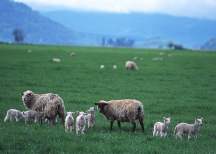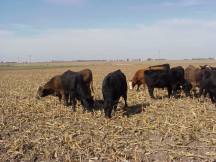Previous Page | Right click this page to print.
Pasture Forages
In the U.S., pasture forages are a significant feedstuff in animal production. In the U.S., pastures provide approximately 36% of the feedstuffs consumed by animals.
Figure 8.11 illustrates the percentage of land per county as being pasture
or rangeland as recorded in the 1987 Census of Agriculture. (Click on
photo for larger image)

Effectiveness of pasture management is monitored via forage and animal
production per unit of land. In the U.S., pastures are economically significant
to the beef cattle, dairy cattle, sheep, and horse industries. In the
U.S. beef industry, pastures are primarily used in cow-calf and stocker
operations. In the U.S. dairy industry, pasture use is limited for lactating
cows as a result of high nutrient requirements for milk production and
limited land area of the operation. More often, pastures are used for
dry-cows and heifers; given land area is available. In the U.S. sheep
industry, pastures are a significant source of feed.
A pasture is simply defined as an area of land with forage grown for animal
consumption via grazing. In general, pastures can be classified as either
cultivated pasture or native pasture. Figure 7-4 on page 132 of the text
illustrates the cultivated or introduced and the native pasture regions
of the U.S. Cultivated or seeded pastures are defined as either receiving
greater than 20 inches of rainfall per year or are irrigated. Examples
of cultivated pastures include cultivated pastures of the Midwest, South,
East, and irrigated in higher rainfall areas of the West.
Figure 8.12 illustrates sheep grazing a cultivated pasture.

Native pastures are defined as pastures receiving less than 20 inches
of rainfall per year. Native species on native pastures are species that
were not introduced and have existed for a period of time. In general,
as a result of forages species and forage management, the nutritional
value and yield of cultivated pastures is higher than the nutritional
value and yield of native pastures. Further, pastures may be classified
as permanent, semi-permanent, or temporary and supplemental. Permanent
pastures are pastures used for many years. For permanent pastures, in
general, pasture is the most profitable use of the land. The majority
of rangelands are classified as permanent pastures. Semi-permanent pastures
are used for a number of years and are a component of a crop rotation
program. Temporary or supplemental pastures are pastures used for a short
period of time. Temporary or supplemental pastures often include annual
species.
The decision to include pasture and range forages in the forage system
requires the consideration of a number of factors. A number of the advantages
of pasture and range forages include: 1) reduced feed cost; 2) reduced
cost of facilities, especially housing facilities; 3) given effective
management, the forages may provide a relatively consistent feedstuff
of high nutritional value; 5) improved animal health; and 6) pastures
provide a productive means to use the land. A number of disadvantages
of pasture and range forages include: 1) for some land, loss in revenue
compared to alternative crops grown on the land; 2) animal management
may be labor intensive in some grazing systems; and 3) the nutritional
value of the forages depends, in part, on environmental and soil conditions.
Yield and nutritional value of pastures are influenced by a number of
factors including plant species, environmental and soil conditions, stage
of maturity, and grazing management. As a number of these factors were
discussed earlier, the discussion in the next section, in general, will
focus on the factors specific to pasture systems.
Grazing management controls the timing and amount of forage grazed to
prevent: 1) a decrease in the number of, yield, and nutritional value
of favorable species; 2) an increase in the number of unfavorable species;
and 3) an increase in soil erosion. Broadly, grazing management systems
are classified as either continuous or intermittent (i.e. rotation).
Continuous grazing is uninterrupted grazing of the pasture throughout
the grazing season. In comparison to rotation grazing, continuous grazing
requires a lower stocking rate, a variable stocking rate throughout the
season, and larger pastures. During periods of adequate forage yield and
nutritional value, continuous grazing may be as productive as rotation
systems. Advantages of continuous grazing are: 1) lower fencing and watering
costs; 2) lower labor costs; and 3) less knowledge of forage management.
The disadvantages of continuous grazing are: 1) variable stocking rate
may be an issue; 2) difficult to manage favorable and unfavorable forage
species; 3) more difficult to harvest and store excess forage; and 4)
supplementation required to compensate for forage deficits.
Rotation grazing is a system where two or more pastures are grazed and
rested in a planned sequence. The primary factor to consider is time;
time of grazing and time of rest for the pasture. Time of grazing and
time of rest are determined by forage growth and animal consumption. Forage
growth is influenced by factors such as soil and environmental conditions.
Rotation grazing systems promote nutritional value and yield of the forage
over time. During less productive time periods, rotation grazing systems
are more productive compared to continuous grazing systems. The advantages
of rotation grazing are: 1) increased yield and nutritional value of forage;
2) improved stand persistence; 3) facilitates removal of excess forage
as silage or hay; 4) increased carrying capacity of the land; 5) promotes
equal defoliation; and 6) reduced incidence of animal disease. Disadvantages
of rotation grazing are: 1) higher capital costs; 2) higher labor costs;
and 3) more knowledge of forage management. One example of a rotation
grazing system for cultivated pastures is intensive rotation grazing.
In addition to the primary forage species discussed, there are a number
of additional forages used as pasture forages. Rape and kale are grazed
by sheep. Beets and turnips are grazed by cattle and sheep. As winter
pastures, cereal grains may be grown for forage. As supplemental summer
pastures, annuals may be grown for forage. Crop residues may be grazed
by animals following harvest. Crop residues include stover, chaff, straw,
stalkage, and huskage.
Figure 8.13 illustrates cattle grazing corn crop residue.

In general, the forage residues are grazed by animals with lower nutrient
requirements and the animals require supplementation with protein and
the various micronutrients.
Previous Page | Right click this page to print.